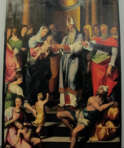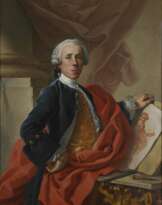Leonardo da Pistoia (1502 - 1548)

Leonardo da Pistoia
Leonardo da Pistoia, also known as Leonardo Grazia, was an Italian painter born in 1502 in Pistoia, Tuscany, and active during the Mannerism period. His career spanned until approximately 1548, during which he made significant contributions to the Italian Renaissance.
Leonardo da Pistoia's work was notably influenced by two renowned artists of the time, Fra Bartolomeo and Raphael. He is often credited for his ability to emulate Raphael's style, evident in works like his "Madonna and Child" (1516), housed in the Staatliche Museen, Berlin, which is a free copy of Raphael's "Madonna del Baldacchino." Another of his works, housed in Brussels, is derived from Raphael's "Bridgewater Madonna." These pieces reflect da Pistoia's admiration and skilled interpretation of Raphael's first and second-decade creations.
Leonardo da Pistoia's life and career were spent primarily in Italy, working in notable cities such as Rome and Naples. In Rome, he worked under Gianfrancesco Penni, known as "il Fattore," and was a copyist of Raphael's paintings. His transition to Naples marked a significant period in his career where he contributed to churches like Santa Maria del Parto a Mergellina, San Domenico Maggiore, and Monte Oliveto. His pupils in Naples included notable artists like Girolamo Siciolante da Sermoneta and Francesco Curia.
Leonardo da Pistoia's work "Cleopatra," which portrays the Egyptian queen with an asp around her neck, is a testament to his mastery in blending realism with allegorical elements. This painting, initially attributed to various artists including Bronzino and Giulio Romano, has been credited to Leonardo da Pistoia, reflecting his influence from Roman, Neapolitan, and Tuscan artistic styles.
For art collectors and experts in art history, Leonardo da Pistoia's work offers a glimpse into the evolving styles of the Italian Renaissance, particularly in how he skillfully adopted and adapted the techniques of his more famous contemporaries. His paintings, rich in historical and artistic value, are a testament to the vibrant and dynamic art scene of Renaissance Italy.
To learn more about Leonardo da Pistoia and stay informed about events and opportunities related to his work, sign up for updates on sales and auction events.
| Date and place of birt: | 1502, Pistoia, Italy |
|---|---|
| Date and place of death: | 26 june 1548, Naples, Italy |
| Period of activity: | XVI century |
| Specialization: | Artist, Painter |
| Art school / group: | Neapolitan school |
| Genre: | Mythological painting, Religious genre |
| Art style: | Mannerism, Old Masters, Renaissance |















